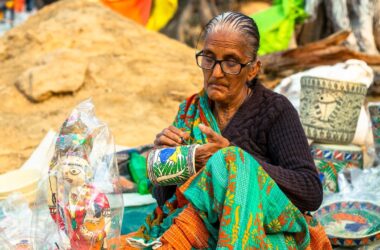Sunderbans Sustainable Tourism: The Sunderbans is a UNESCO World Heritage site and the world’s largest delta formed by the confluence of the Ganges, Brahmaputra, and Meghna rivers in India and Bangladesh. It is home to the world-famous Royal Bengal Tiger and several other endangered species of flora and fauna. Sustainable tourism practices in the Sunderbans are vital for the conservation of the region’s natural and cultural heritage, while also promoting responsible travel practices. This article explores Sunderbans’ sustainable tourism practices and initiatives that aim to promote responsible tourism practices while preserving the region’s natural and cultural heritage.
Sunderbans’ Sustainable Tourism Practices
- Eco-tourism
Eco-tourism is a significant sustainable tourism practice in the Sunderbans, promoting responsible travel while minimizing the negative impact on the environment. The region has several eco-friendly accommodations, including treehouses, cottages, and boats, that use renewable energy sources and minimize their impact on the environment. Visitors can participate in eco-tourism activities, such as birdwatching, jungle treks, and boat tours, while appreciating the region’s natural beauty and wildlife.
- Community-Based Tourism
Community-based tourism is another sustainable tourism practice in the Sunderbans that involves the local community in tourism activities, promotes sustainable use of natural and cultural resources, and supports the local economy. Visitors can participate in village tours, homestays, and cultural exchanges to learn about the local culture, customs, and way of life. Community-based tourism initiatives also provide economic benefits to the local community, including job opportunities and income generation.
- Waste Management
Waste management is a critical aspect of sustainable tourism in the Sunderbans, as the region’s fragile ecosystem is sensitive to pollution and waste. The Sunderbans has implemented several waste management initiatives to manage the waste generated by tourists and locals, including the promotion of responsible tourism practices. Visitors are encouraged to carry reusable bags and containers and to segregate their waste. Waste management facilities and composting units have also been established to manage the waste generated in the region.
- Cultural Preservation
The Sunderbans is home to several indigenous communities with their unique cultures, customs, and traditions. Cultural preservation is an essential aspect of sustainable tourism in the Sunderbans, as it promotes the preservation of the region’s cultural heritage and provides economic opportunities for the local community. The region has established several cultural centers, museums, and festivals that showcase the region’s cultural heritage and provide visitors with an opportunity to learn about the local community’s way of life.
- Renewable Energy
Renewable energy is an essential aspect of sustainable tourism in the Sunderbans, as it minimizes the region’s carbon footprint and promotes sustainable tourism practices. The region has implemented several renewable energy initiatives, including the use of solar power and wind turbines in eco-friendly accommodations and boats. Water conservation practices, such as rainwater harvesting, are also implemented to minimize the impact on the environment.
Similar Articles
- Andaman and Nicobar Islands Sustainable Tourism
- Sikkim Sustainable Tourism Practices
- Kabini: Preserving Natural Beauty and Supporting Local Communities
- Chilika Lake: Preserving Biodiversity and Empowering Communities
Frequently Asked Questions About Sunderbans Sustainable Tourism Practices
What is sustainable tourism?
Sustainable tourism is a type of tourism that promotes responsible travel practices while minimizing the negative impact on the environment, local communities, and cultural heritage. It involves activities that support conservation efforts, promote the local economy, and respect the local culture and customs.
How does the Sunderbans promote sustainable tourism practices?
The Sunderban’s promotes sustainable tourism practices through eco-tourism, waste management, community-based tourism, cultural preservation, and renewable energy initiatives. These initiatives are aimed at preserving the region’s natural environment, supporting the local economy, and preserving its cultural heritage.
What is eco-tourism, and how does it promote sustainable tourism practices?
Eco-tourism is a type of tourism that focuses on responsible travel practices while minimizing the negative impact on the environment. It involves activities such as birdwatching, jungle treks, and boat tours, while appreciating the region’s natural beauty and wildlife. Eco-tourism promotes sustainable tourism practices by supporting the conservation of natural resources and reducing the negative impact of tourism on the environment.
How does waste management promote sustainable tourism in the Sunderbans?
Waste management is critical to sustainable tourism, as the region’s fragile ecosystem is sensitive to pollution and waste. Waste management initiatives, such as promoting responsible tourism practices, waste segregation, and composting units, minimize the negative impact of tourism on the environment and preserve the region’s natural beauty and wildlife.
What is community-based tourism, and how does it benefit the local community in the Sunderbans?
Community-based tourism is a type of tourism that involves the local community in tourism activities, promotes sustainable use of natural and cultural resources, and supports the local economy. Community-based tourism initiatives provide economic benefits to the local community, including job opportunities and income generation, while promoting the region’s natural and cultural heritage.
What is cultural preservation, and how does it promote sustainable tourism in the Sunderbans?
Cultural preservation is an essential aspect of sustainable tourism in the Sunderbans, as it promotes the preservation of the region’s cultural heritage and provides economic opportunities for the local community. Cultural preservation initiatives, such as establishing cultural centers, museums, and festivals, showcase the region’s cultural heritage and provide visitors with an opportunity to learn about the local community’s way of life.
How does renewable energy promote sustainable tourism in the Sunderbans?
Renewable energy is an essential aspect of sustainable tourism in the Sunderbans, as it minimizes the region’s carbon footprint and promotes sustainable tourism practices. Renewable energy initiatives, such as the use of solar power and wind turbines in eco-friendly accommodations and boats, minimize the impact of tourism on the environment and promote responsible travel practices.











I don’t think the title of your article matches the content lol. Just kidding, mainly because I had some doubts after reading the article.
Your article helped me a lot, is there any more related content? Thanks! https://accounts.binance.com/es-MX/register?ref=JHQQKNKN
Your point of view caught my eye and was very interesting. Thanks. I have a question for you.